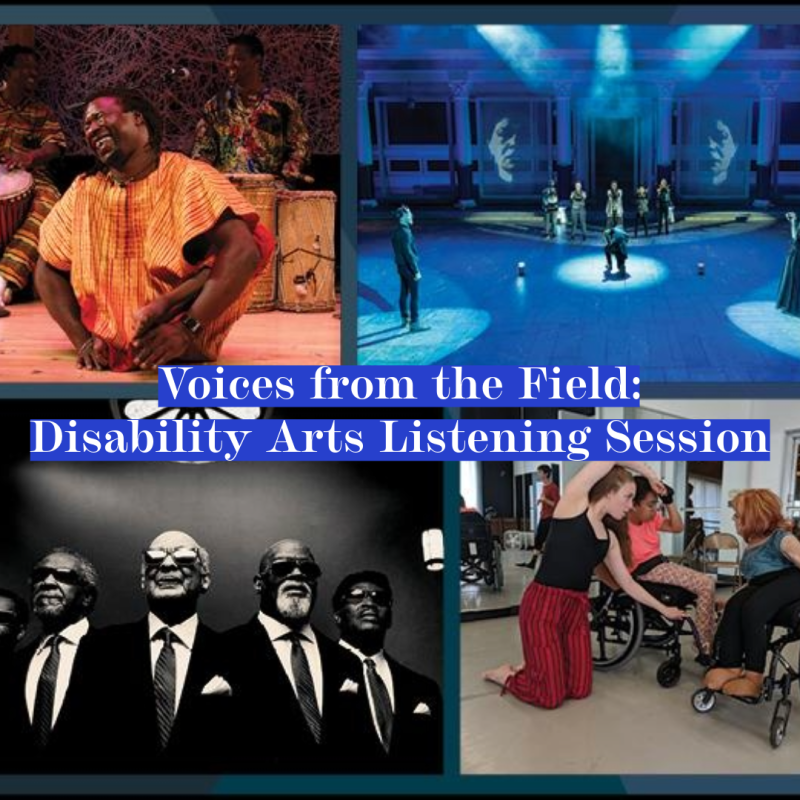Voices From the Field: What We Learned from a Disability Arts Listening Session (Part Two: What's Needed)

On September 30, 2024, we held a listening session to find out what disabled artists need to do their work in a healthy, safe, and productive environment. In our last blog we looked at the barriers to working in the arts, which included such longstanding issues as inaccessibility of arts spaces and programs and asset limits for those receiving disability benefits. We also heard about the toll of having to continuously educate people about access needs and concerns from those who are vulnerable to the effects of COVID-19 about returning to in-person arts programming in environments that have not maintained safety protocols.
Our discussion also served to gather examples around the solutions and actions that artists and arts organizations are taking to make arts work easier and more viable. In this post we look at the offered solutions, best practices, and things that arts organizations should consider when engaging and working with disabled artists, keeping in mind that these solutions can help all artists create, exhibit, teach, and perform.
What’s needed
Throughout the listening session, participants cited several best practices to help create truly inclusive and accessible arts spaces and practices. One major theme across the responses was an urgent need for adequate funding for accessibility, including administrative and legal support, the provision of necessary modifications and services, and sustaining ongoing educational efforts.
Participants representing arts organizations came to the discussion topic of “What’s Needed” at different stages in their implementation of accessibility improvements. For some, there were still large barriers (i.e. time and funding constraints) and others were actively pursuing one or more of the following best practices.
Build capacity. While several participants elevated the need for accessibility-specific staff (i.e. accessibility coordinators), there is also a need for all staff to be knowledgeable about their responsibility to provide access services and accommodations. As one participant said, “It is really useful if everyone sees themselves as a part of the access team. It is not just one person or one part of the organization.” Many participants said that there must be greater availability of disability-focused training and learning opportunities for people in arts spaces on topics such as respectful disability language, recognizing the diversity of lived experiences of people with disabilities (i.e., people with different types of disabilities, such as those acquired and lifelong, or apparent and non-apparent disabilities), and accessibility requirements related to federal funding.
Communicate accessibility expectations. There are numerous ways that organizations can show that they are intentionally thinking about accessibility. A few examples include developing and sharing an accessibility policy and grievance process. One participant suggested that funders should provide plain-language application materials and clear guidance on the requirements and responsibilities grantees have for the accessibility of their funded programs and facilities.
Budget for accessibility. An important way to demonstrate commitment to accessibility is by dedicating funding to support accessibility efforts. This can include an accessibility staff position such as an accessibility coordinator and/or a line item in grant budgets for access services and accommodations.
Ask about access needs. A useful best practice is checking in on everyone’s access needs at the start of a project. Asking artists and other participants what their access needs are up front creates a welcoming environment for accommodation requests throughout a project. Asking this question of everyone, not just those with disabilities, also facilitates open, comfortable communication. One participant said of their experiences, “I also learned [the importance of] taking a moment at the beginning of each rehearsal to create a safe space and then check in with everyone each day.” Different styles and modes of communication can pose challenges in connecting and checking in with one another, so a listening session participant who uses an augmentative and alternative communication (AAC) device to communicate suggested having a “communication doula” to facilitate communication in arts spaces.
Be responsive to COVID-19 concerns. As noted in the last blog, COVID-19 remains a significant concern for members of the disability community. Participants suggested ways organizations could continue to recognize the impact of COVID-19 and encouraged organizations to take precautions. For example, a participant who expressed concern about COVID safety made this recommendation to arts funders: “I would love granting organizations to incentivize entities to practice barrier reduction and community care by positively weighing [grant] applicants that practice virus safety, such as masking and improved air quality.” Organizations can also continue to offer virtual or hybrid options for arts activities.
We will continue to share reflections from the disability arts listening session through our next blog post which will focus on the third discussion topic: The ideal scenario – A “blue sky” vision for the best environment for artistic creation and learning that accommodates people’s access needs.
We would like to thank author and communications consultant Emily Ladau for her assistance with synthesizing the findings from this listening session, as well as the participants who contributed to the conversation.
Beth Bienvenu is the director of the Office of Accessibility at the National Endowment for the Arts, and Katharine Hayward is the NEA’s Accessibility Specialist. Beth and Katharine manage the NEA's technical assistance and advocacy work devoted to making the arts accessible for people with disabilities, older adults, veterans, and people in institutional settings.






